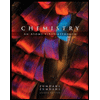
Introductory Chemistry: A Foundation
9th Edition
ISBN: 9781337399425
Author: Steven S. Zumdahl, Donald J. DeCoste
Publisher: Cengage Learning
expand_more
expand_more
format_list_bulleted
Concept explainers
Textbook Question
Chapter 16, Problem 64QAP
. A buffered solution is prepared containing acetic acid, HC2H3O2, and sodium acetate, NaC2H3O2, both at 0.5 M. Write a chemical equation showing how this buffered solution would resist a decrease in its pH if a few drops of aqueous strong acid HCI solution were added to it. Write a chemical equation showing how this buffered solution would resist an increase in its pH if a few drops of aqueous strong base NaOH solution were added to it.
Expert Solution & Answer
Want to see the full answer?
Check out a sample textbook solution
Chapter 16 Solutions
Introductory Chemistry: A Foundation
Ch. 16.1 - Exercise 16.1 Which of the following represent...Ch. 16.2 - Vinegar contains acetic acid and is used in salad...Ch. 16.3 - Exercise 16.2 Calculate [H+] in a solution in...Ch. 16.4 - Prob. 16.3SCCh. 16.4 - Prob. 1CTCh. 16.4 - Prob. 16.4SCCh. 16.4 - Exercise 16.5 The pH of rainwater in a polluted...Ch. 16.4 - Exercise 16.6 The pOH of a liquid drain cleaner...Ch. 16.5 - Exercise 16.7 Calculate the pH of a solution of...Ch. 16 - You are asked for the H+ concentration in a...
Ch. 16 - Explain why Cl- does not affect the pH of an...Ch. 16 - Write the general reaction for an acid acting in...Ch. 16 - Differentiate among the terms concentrated,...Ch. 16 - What is meant by “pH”? True or false: A strong...Ch. 16 - Consider two separate solutions: one containing a...Ch. 16 - Prob. 7ALQCh. 16 - Prob. 8ALQCh. 16 - Stanley’s grade-point average (GPA) is 3.28. What...Ch. 16 - Prob. 10ALQCh. 16 - . Mixing together aqueous solutions of acetic acid...Ch. 16 - Prob. 12ALQCh. 16 - . Consider the equation:...Ch. 16 - . Choose the answer that best completes the...Ch. 16 - Prob. 15ALQCh. 16 - . The following figures are molecular-level...Ch. 16 - Prob. 17ALQCh. 16 - What are some physical properties that...Ch. 16 - Write an equation showing how HCl(g) behaves as an...Ch. 16 - Prob. 3QAPCh. 16 - How do the components of a conjugate acid—base...Ch. 16 - 5. Given the general equation illustrating the...Ch. 16 - According to Arrhenius, ____________ produce...Ch. 16 - Which of the following do not represent a...Ch. 16 - Which of the following do not represent a...Ch. 16 - In each of the following chemical equations,...Ch. 16 - . In each of the following chemical equations,...Ch. 16 - . Write the conjugate acid for each of the...Ch. 16 - . Write the conjugate acid for each of the...Ch. 16 - Prob. 13QAPCh. 16 - . Write the conjugate base for each of the...Ch. 16 - . Write a chemical equation showing how each of...Ch. 16 - . Write a chemical equation showing how each of...Ch. 16 - . What does it mean to say that an acid is strong...Ch. 16 - Prob. 18QAPCh. 16 - . How is the strength of an acid related to the...Ch. 16 - . A strong acid has a weak conjugate base, whereas...Ch. 16 - . Write the formula for the hydronium ion. Write...Ch. 16 - Prob. 22QAPCh. 16 - . Organic acids contain the carboxyl group Using...Ch. 16 - Prob. 24QAPCh. 16 - 25. Which of the following acids have relatively...Ch. 16 - . The “Chemistry in Focus” segment Plants Fight...Ch. 16 - . Water is the most common amphoteric substance,...Ch. 16 - . Anions containing hydrogen (for example. HCO3and...Ch. 16 - . What is meant by the iou-product constant for...Ch. 16 - . What happens to the hydroxide ion concentration...Ch. 16 - Prob. 31QAPCh. 16 - Prob. 32QAPCh. 16 - . Calculate the [OH-] in each of the following...Ch. 16 - . Calculate the [OH-] in each of the following...Ch. 16 - 35. For each pair of concentrations, tell which...Ch. 16 - . For each pair of concentrations, tell which...Ch. 16 - . Why do scientists tend to express the acidity of...Ch. 16 - . Using Fig. 16.3, list the approximate pH value...Ch. 16 - . For a hydrogen ion concentration of 2.33106M,...Ch. 16 - . The “Chemistry in Focus” segment Garden-Variety...Ch. 16 - . Calculate the pH corresponding to each of the...Ch. 16 - Prob. 42QAPCh. 16 - Prob. 43QAPCh. 16 - Prob. 44QAPCh. 16 - Prob. 45QAPCh. 16 - . Calculate the pOH value corresponding to each of...Ch. 16 - . For each hydrogen ion concentration listed,...Ch. 16 - . For each hydrogen ion concentration listed,...Ch. 16 - . Calculate the hydrogen ion concentration, in...Ch. 16 - . Calculate the hydrogen ion concentration, in...Ch. 16 - . Calculate the hydrogen ion concentration, in...Ch. 16 - . Calculate the hydrogen ion concentration, in...Ch. 16 - . Calculate the pH of each of the following...Ch. 16 - Prob. 54QAPCh. 16 - 55. When 1 mole of gaseous hydrogen chloride is...Ch. 16 - . A bottle of acid solution is labeled “3 M HNO3.”...Ch. 16 - . Calculate the hydrogen ion concentration and the...Ch. 16 - . Calculate the pH of each of the following...Ch. 16 - . What characteristic properties do buffered...Ch. 16 - Prob. 60QAPCh. 16 - . Which component of a buffered solution is...Ch. 16 - Prob. 62QAPCh. 16 - . Which of the following combinations would act as...Ch. 16 - . A buffered solution is prepared containing...Ch. 16 - . The concepts of acid-base equilibria were...Ch. 16 - . Strong buses are bases that completely ionize in...Ch. 16 - Prob. 67APCh. 16 - Prob. 68APCh. 16 - Prob. 69APCh. 16 - Prob. 70APCh. 16 - Prob. 71APCh. 16 - Prob. 72APCh. 16 - Prob. 73APCh. 16 - Prob. 74APCh. 16 - 75. A conjugate acid-base pair Consists of two...Ch. 16 - . Acetate ion, C2H3O2- , has a stronger affinity...Ch. 16 - Prob. 77APCh. 16 - Prob. 78APCh. 16 - Prob. 79APCh. 16 - Prob. 80APCh. 16 - Prob. 81APCh. 16 - Prob. 82APCh. 16 - Prob. 83APCh. 16 - Prob. 84APCh. 16 - . A(n) _________ solution contains a conjugate...Ch. 16 - . When sodium hydroxide, NaOH, is added dropwise...Ch. 16 - . When hydrochloric acid, HCI. is added dropwise...Ch. 16 - . The following are representations of acid-base...Ch. 16 - . In each of the following chemical equations,...Ch. 16 - Prob. 90APCh. 16 - . Write the conjugate base for each of the...Ch. 16 - . Of the following combinations, which would act...Ch. 16 - Prob. 93APCh. 16 - . Calculate [H+] in each of the following...Ch. 16 - Prob. 95APCh. 16 - . Calculate the pH corresponding to each of the...Ch. 16 - Prob. 97APCh. 16 - Prob. 98APCh. 16 - Prob. 99APCh. 16 - . For each hydrogen or hydroxide ion concentration...Ch. 16 - . Calculate the hydrogen ion concentration, in...Ch. 16 - Prob. 102APCh. 16 - Prob. 103APCh. 16 - Prob. 104APCh. 16 - . Write the formulas for three combinations of...Ch. 16 - . Choose pairs in which the species listed first...Ch. 16 - . Complete the table for each of the following...Ch. 16 - . Consider 0.25 M solutions of the following...
Additional Science Textbook Solutions
Find more solutions based on key concepts
Practice Problem 1.22 Which of the following alkenes can exist as cis-trans isomers? Write their structures. Bu...
Organic Chemistry
Determine the de Brogue wavelength of a. an electron moving at 1/10 the speed of light. b. a 400 g Frisbee movi...
Inorganic Chemistry
Draw a Lewis structure for each covalent molecule. a. HBr b. CH3F c. H2O2 d. N2H4 e. C2H6 f. CH2Cl2
Principles of General, Organic, Biological Chemistry
Practice Problem 1.22 Which of the following alkenes can exist as cis-trans isomers? Write their structures. Bu...
Organic Chemistry
Knowledge Booster
Learn more about
Need a deep-dive on the concept behind this application? Look no further. Learn more about this topic, chemistry and related others by exploring similar questions and additional content below.Similar questions
- A buffer solution is prepared by adding 0.125 mol ammonium chloride to 500. mL of 0.500-M aqueous ammonia. Calculate the pH of the buffer. If 0.0100 mol HCl gas is bubbled into 500. mL buffer and all of the gas dissolves, calculate the new pH of the solution.arrow_forwardKa for formic acid is 1.7 104 at 25C. A buffer is made by mixing 529 mL of 0.465 M formic acid, HCHO2, and 494 mL of 0.524 M sodium formate, NaCHO2. Calculate the pH of this solution at 25C after 110 mL of 0.152 M HCl has been added to this buffer.arrow_forwardConsider all acid-base indicators discussed in this chapter. Which of these indicators would be suitable for the titration of each of these? (a) NaOH with HClO4 (b) acetic acid with KOH (c) NH3 solution with HBr (d) KOH with HNO3 Explain your choices.arrow_forward
- A student intends to titrate a solution of a weak monoprotic acid with a sodium hydroxide solution but reverses the two solutions and places the weak acid solution in the buret. After 23.75 mL of the weak acid solution has been added to 50.0 mL of the 0.100 M NaOH solution, the pH of the resulting solution is 10.50. Calculate the original concentration of the solution of weak acid.arrow_forwardWhich of the acid-base indicators discussed in this chapter would be suitable for the titration of (a) HNO3 with KOH. (b) KOH with acetic acid. (c) HCl with NH3. (d) KOH with HNO2. Explain your answers.arrow_forwardCalculate the pH of solutions that are 0.25 M formic acid and 0.40 M sodium formate. 0.50 M benzoic acid and 0.15 M sodium benzoate.arrow_forward
- A solution made up of 1.0 M NH3 and 0.50 M (NH4)2SO4 has a pH of 9.26. a Write the net ionic equation that represents the reaction of this solution with a strong acid. b Write the net ionic equation that represents the reaction of this solution with a strong base. c To 100. mL of this solution, 10.0 mL of 1.00 M HCl is added. How many moles of NH3 and NH4+ are present in the reaction system before and after the addition of the HCl? What is the pH of the resulting solution? d Why did the pH change only slightly upon the addition of HCl?arrow_forwardSodium benzoate, NaC7H5O2, is used as a preservative in foods. Consider a 50.0-mL sample of 0.250 M NaC7H5O2 being titrated by 0.200 M HBr. Calculate the pH of the solution: a when no HBr has been added; b after the addition of 50.0 mL of the HBr solution; c at the equivalence point; d after the addition of 75.00 mL of the HBr solution. The Kb value for the benzoate ion is 1.6 1010.arrow_forwardA solution of weak base is titrated to the equivalence point with a strong acid. Which one of the following statements is most likely to be correct? a The pH of the solution at the equivalence point is 7.0. b The pH of the solution is greater than 13.0. c The pH of the solution is less than 2.0. d The pH of the solution is between 2.0 and 7.0. e The pH of the solution is between 7.0 and 13.0. The reason that best supports my choosing the answer above is a Whenever a solution is titrated with a strong acid, the solution will be very acidic. b Because the solution contains a weak base and the acid (titrant) is used up at the equivalence point, the solution will be basic. c Because the solution contains the conjugate acid of the weak base at the equivalence point, the solution will be acidic.arrow_forward
- Estimate the pH that results when the following two solutions are mixed. a) 50 mL of 0.3 M CH3COOH and 50 mL of 0.4 M KOH b) 100 mL of 0.3 M CH3COOH and 50 mL of 0.4 M NaOH c) 150 mL of 0.3 M CH3COOH and 100 mL of 0.3 M Ba(OH)2 d) 200 mL of 0.3 M CH3COOH and 100 mL of 0.3 M Ba(OH)2arrow_forwardA quantity of 0.25 M sodium hydroxide is added to a solution containing 0.15 mol of acetic acid. The final volume of the solution is 375 mL and the pH of this solution is 4.45. a What is the molar concentration of the sodium acetate? b How many milliliters of sodium hydroxide were added to the original solution? c What was the original concentration of the acetic acid?arrow_forwardWhat is the pH of a buffer that is 0.150 M in a weak acid and 0.150 M in the acids conjugate base? The acids ionization constant is 6.8 106.arrow_forward
arrow_back_ios
SEE MORE QUESTIONS
arrow_forward_ios
Recommended textbooks for you
 Introductory Chemistry: A FoundationChemistryISBN:9781337399425Author:Steven S. Zumdahl, Donald J. DeCostePublisher:Cengage Learning
Introductory Chemistry: A FoundationChemistryISBN:9781337399425Author:Steven S. Zumdahl, Donald J. DeCostePublisher:Cengage Learning Chemistry: An Atoms First ApproachChemistryISBN:9781305079243Author:Steven S. Zumdahl, Susan A. ZumdahlPublisher:Cengage Learning
Chemistry: An Atoms First ApproachChemistryISBN:9781305079243Author:Steven S. Zumdahl, Susan A. ZumdahlPublisher:Cengage Learning ChemistryChemistryISBN:9781305957404Author:Steven S. Zumdahl, Susan A. Zumdahl, Donald J. DeCostePublisher:Cengage Learning
ChemistryChemistryISBN:9781305957404Author:Steven S. Zumdahl, Susan A. Zumdahl, Donald J. DeCostePublisher:Cengage Learning
 Chemistry: The Molecular ScienceChemistryISBN:9781285199047Author:John W. Moore, Conrad L. StanitskiPublisher:Cengage Learning
Chemistry: The Molecular ScienceChemistryISBN:9781285199047Author:John W. Moore, Conrad L. StanitskiPublisher:Cengage Learning General Chemistry - Standalone book (MindTap Cour...ChemistryISBN:9781305580343Author:Steven D. Gammon, Ebbing, Darrell Ebbing, Steven D., Darrell; Gammon, Darrell Ebbing; Steven D. Gammon, Darrell D.; Gammon, Ebbing; Steven D. Gammon; DarrellPublisher:Cengage Learning
General Chemistry - Standalone book (MindTap Cour...ChemistryISBN:9781305580343Author:Steven D. Gammon, Ebbing, Darrell Ebbing, Steven D., Darrell; Gammon, Darrell Ebbing; Steven D. Gammon, Darrell D.; Gammon, Ebbing; Steven D. Gammon; DarrellPublisher:Cengage Learning

Introductory Chemistry: A Foundation
Chemistry
ISBN:9781337399425
Author:Steven S. Zumdahl, Donald J. DeCoste
Publisher:Cengage Learning

Chemistry: An Atoms First Approach
Chemistry
ISBN:9781305079243
Author:Steven S. Zumdahl, Susan A. Zumdahl
Publisher:Cengage Learning

Chemistry
Chemistry
ISBN:9781305957404
Author:Steven S. Zumdahl, Susan A. Zumdahl, Donald J. DeCoste
Publisher:Cengage Learning


Chemistry: The Molecular Science
Chemistry
ISBN:9781285199047
Author:John W. Moore, Conrad L. Stanitski
Publisher:Cengage Learning

General Chemistry - Standalone book (MindTap Cour...
Chemistry
ISBN:9781305580343
Author:Steven D. Gammon, Ebbing, Darrell Ebbing, Steven D., Darrell; Gammon, Darrell Ebbing; Steven D. Gammon, Darrell D.; Gammon, Ebbing; Steven D. Gammon; Darrell
Publisher:Cengage Learning
General Chemistry | Acids & Bases; Author: Ninja Nerd;https://www.youtube.com/watch?v=AOr_5tbgfQ0;License: Standard YouTube License, CC-BY